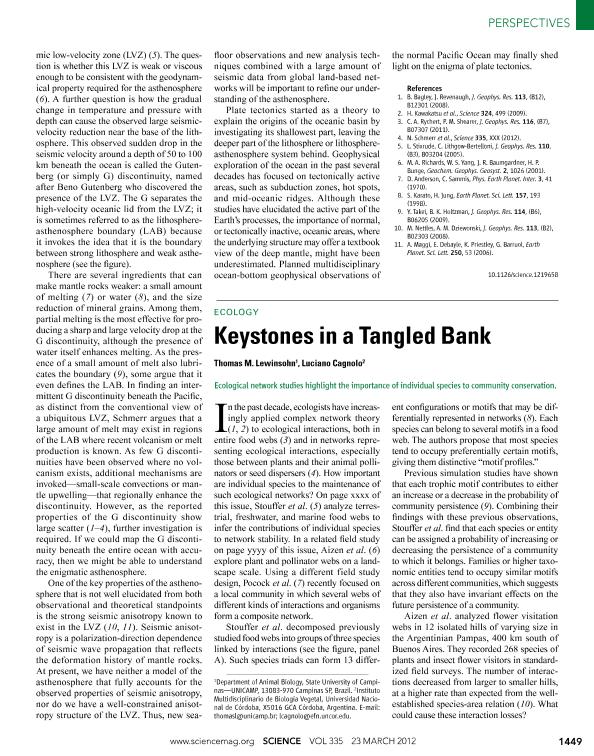Mostrar el registro sencillo del ítem
dc.contributor.author
Lewinsohn, Thomas
dc.contributor.author
Cagnolo, Luciano

dc.date.available
2017-01-31T20:22:12Z
dc.date.issued
2012-03
dc.identifier.citation
Lewinsohn, Thomas; Cagnolo, Luciano; Keystones in a Tangled Bank: Ecological network studies highlight the importance of individual species to community conservation; American Association For The Advancement Of Science; Science; 335; 6675; 3-2012; 1449-1451
dc.identifier.issn
0036-8075
dc.identifier.uri
http://hdl.handle.net/11336/12274
dc.description.abstract
In the past decade, ecologists have increasingly applied complex network theory (1, 2) to ecological interactions, both in entire food webs (3) and in networks representing ecological interactions, especially those between plants and their animal pollinators or seed dispersers (4). How important are individual species to the maintenance of such ecological networks? On page 1489 of this issue, Stouffer et al. (5) analyze terrestrial, freshwater, and marine food webs to infer the contributions of individual species to network stability. In a related field study on page 1486 of this issue, Aizen et al. (6) explore plant and pollinator webs on a landscape scale. Using a different field study design, Pocock et al. (7) recently focused on a local community in which several webs of different kinds of interactions and organisms form a composite network.
dc.format
application/pdf
dc.language.iso
eng
dc.publisher
American Association For The Advancement Of Science

dc.rights
info:eu-repo/semantics/openAccess
dc.rights.uri
https://creativecommons.org/licenses/by-nc-sa/2.5/ar/
dc.subject
Interaction Networks
dc.subject
Food Webs
dc.subject
Nestedness
dc.subject
Modularity
dc.subject.classification
Ecología

dc.subject.classification
Ciencias Biológicas

dc.subject.classification
CIENCIAS NATURALES Y EXACTAS

dc.title
Keystones in a Tangled Bank: Ecological network studies highlight the importance of individual species to community conservation
dc.type
info:eu-repo/semantics/article
dc.type
info:ar-repo/semantics/artículo
dc.type
info:eu-repo/semantics/publishedVersion
dc.date.updated
2017-01-31T15:34:43Z
dc.journal.volume
335
dc.journal.number
6675
dc.journal.pagination
1449-1451
dc.journal.pais
Estados Unidos

dc.description.fil
Fil: Lewinsohn, Thomas. Universidade Estadual de Campinas; Brasil
dc.description.fil
Fil: Cagnolo, Luciano. Consejo Nacional de Investigaciones Científicas y Técnicas. Centro Científico Tecnológico Córdoba. Instituto Multidisciplinario de Biología Vegetal (p); Argentina
dc.journal.title
Science

dc.relation.alternativeid
info:eu-repo/semantics/altIdentifier/doi/http://dx.doi.org/10.1126/science.1220138
dc.relation.alternativeid
info:eu-repo/semantics/altIdentifier/url/http://science.sciencemag.org/content/335/6075/1449
Archivos asociados
